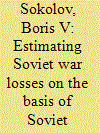| Srl | Item |
| 1 |
ID:
133763


|
|
|
|
|
| Publication |
2014.
|
| Summary/Abstract |
The problem of calculating the Soviet losses in the Second World War has confronted scholars with potentially insoluble difficulties. Especially in the first year of the war, during the catastrophic defeats and disorganized retreats, individual records on Soviet military personnel were either simply not kept or were lost or destroyed. Even during the war, the Soviet government criticized the failure to keep casualty lists up to date and noted that often soldiers were killed or went missing even before they were formally added to the unit rosters. The Red Army had no equivalent to the dog tag. Many soldiers, out of superstition, refused to wear the smertniki-little wooden cases that held identification information on slips of paper-believing that a wearer was ordained to die. Official estimates to this date, however, appear plainly understated. The author proposes a new method for estimating the Soviet personnel losses in the Second World War, based on the 1939 and 1956 censuses of the Soviet population.
|
|
|
|
|
|
|
|
|
|
|
|
|
|
|
|
| 2 |
ID:
097760


|
|
|
|
|
| Publication |
2010.
|
| Summary/Abstract |
The article provides an analysis of the regional input into NKVD order 00447, the deadliest of the 1937-1938 state terror attacks on the Soviet population. This regional input concerned the decision to establish regional troikas, the choice of the target groups, the size of the initial limits, the extension of the deadline for completing the operation, the relationship between the initial limits and the final number of victims, the relationship between the final limits and the final number of victims, the actual victims, and unauthorised terror. It is argued that the formulation and implementation of order 00447 was a dynamic process of interaction between the centre and the regions in which the regions played a significant, but subordinate, role.
|
|
|
|
|
|
|
|
|
|
|
|
|
|
|
|